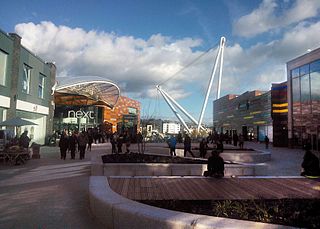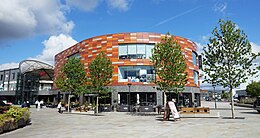
The Westgate Hotel, Commercial Street, Newport, Wales is a hotel building dating from the 19th century. On 4 November 1839 the hotel saw the major scenes of the Newport Rising, when 3,000 Chartists, some of them armed, led by John Frost marched on Newport to attempt to secure the release of five of their number who were being held under arrest at the hotel. In the fighting between about 60 soldiers of the 45th Regiment of Foot and police on one side, and a larger number of Chartists on the other, 10-22 Chartists were killed and more than 50 wounded. The hotel is a Grade II listed building.

Caerleon is a town and community in Newport, Wales. Situated on the River Usk, it lies 5 miles (8 km) northeast of Newport city centre, and 5.5 miles (9 km) southeast of Cwmbran. Caerleon is of archaeological importance, being the site of a notable Roman legionary fortress, Isca Augusta, and an Iron Age hillfort. Close to the remains of Isca Augusta are the National Roman Legion Museum and the Roman Baths Museum. The town also has strong historical and literary associations: Geoffrey of Monmouth elevated the significance of Caerleon as a major centre of British history in his Historia Regum Britanniae, and Alfred Lord Tennyson wrote Idylls of the King (1859–1885) while staying in Caerleon.

Newport is a city and county borough in Wales, situated on the River Usk close to its confluence with the Severn Estuary, 12 mi (19 km) northeast of Cardiff. With a population of 145,700 at the 2011 census, Newport is the third-largest authority with city status in Wales, and seventh most populous overall. Newport became a unitary authority in 1996 and forms part of the Cardiff-Newport metropolitan area. Newport was the site of the last large-scale armed insurrection in Great Britain, the Newport Rising of 1839. The population grew considerably during the 2021 census, rising to 159,587, the largest growth of a unitary authority in Wales.

Cardiff city centre is the city centre and central business district of Cardiff, Wales. The area is tightly bound by the River Taff to the west, the Civic Centre to the north and railway lines and two railway stations – Central and Queen Street – to the south and east respectively. Cardiff became a city in 1905.
Swansea city centre in Swansea, Wales, contains the main shopping, leisure and nightlife district in Swansea. The city centre covers much of the Castle ward including the area around Oxford Street, Castle Square, and the Quadrant Shopping Centre; Alexandra Road, High Street, Wind Street and the Castle; Parc Tawe; and the Maritime Quarter extending down to the seafront.

Newport Unlimited was a Welsh Urban Regeneration Company created in 2003 to help counter the impacts of decline in Newport's heavy industry and manufacturing. It was initially given a 10-year lifespan.

The Kingsway Shopping Centre is an under-cover shopping centre in Newport city centre, Wales. The northern pedestrian entrance is on John Frost Square adjoining the Friars Walk shopping and leisure complex. The east pedestrian entrance is off Commercial Street. The west pedestrian entrance is on Emlyn Street. The centre is a short walk from the high street shops of Commercial Street and High Street. Newport railway station is also a short walk away.

Newport Museum and Art Gallery is a museum, library and art gallery in the city of Newport, South Wales. It is located in Newport city centre on John Frost Square and is adjoined to the Kingsway Shopping Centre.

Friars Walk is a partially under-cover shopping centre and leisure complex in Newport city centre, South Wales. It has several levels and includes a range of high street shops, eateries, a cinema, a bowling alley and a soft play area. The complex is linked by the redeveloped John Frost Square to the Kingsway Shopping Centre, Newport Museum, Art Gallery and Central Library and Newport bus station. The complex is a short walk from the high street shops of Commercial Street and High Street. Newport railway station is also a short walk away.

Newport Central bus station is a bus terminus and interchange located in the city centre, Newport, South Wales. It is the largest road transport hub for public services in the county. It is situated on the Newport Market site and the adjacent Friars Walk site.

Newport Market is a traditional Victorian indoor market, in Newport, South Wales. It is an early example of a large-span cast iron-frame building featuring a glass-filled barrel roof.

Kingsway is a shopping, dining and entertainment precinct at the town centre of Glen Waverley, a southeastern suburb of Melbourne, Victoria, Australia. It starts off at the northern end from High Street, and runs north-south parallel to Springvale Road before curving east at its southern end to join the latter as a T-intersection.

The Chartist Mural was a mosaic mural designed by Kenneth Budd and created in 1978 in a pedestrian underpass in Newport, Wales. It commemorated the Newport Rising of 1839, in which an estimated 22 demonstrators were killed by troops. It was 115 feet (35 m) long and 13 feet (4.0 m) high. The mural was demolished in 2013 amid considerable controversy and misinformation. The original decision to remove the artwork was taken in 2005 by the Labour Controlled Council to allow Modus development company to build the Friars Walk shopping centre. Modus were removed by the Conservative/Lib Dem coalition Council after taking control in 2008 and replaced with Queensbury Development Company Friars Walk.

John Frost Square is a large public space in the centre of Newport, South Wales, named after the Chartist leader, John Frost. It was redeveloped as part of the Friars Walk shopping and leisure complex in 2014 and 2015.

Commercial Street is a 700-yard (660-metre) long main shopping street leading from the city centre of Newport, South Wales.

High Street is the main historical street and the original main thoroughfare in the centre of Newport, South Wales. Nowadays it runs approximately 280m between Westgate Square and the Old Green Interchange.

National Cycle Route 88 is a route of the National Cycle Network, running from Newport to its planned finish site at Margam.

Chartist Tower is a 53.3 metre tall high rise building in west Newport, Wales. It was built in 1966, and is the tallest building in the city.






















